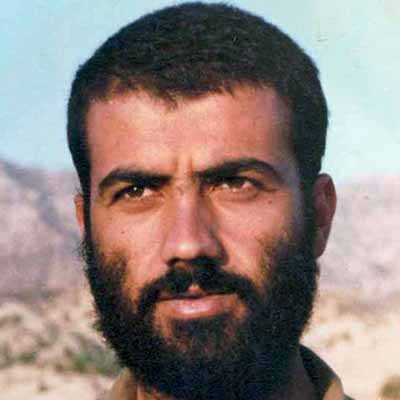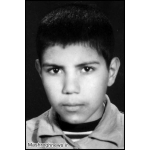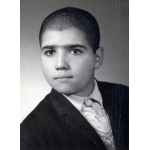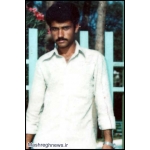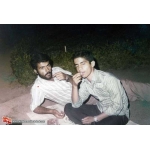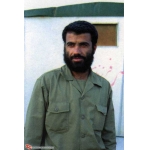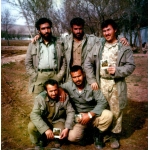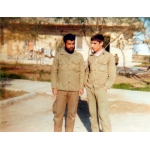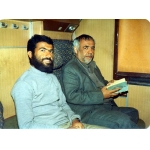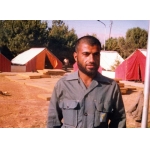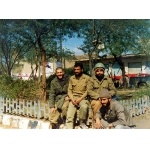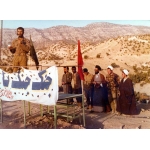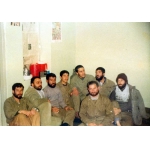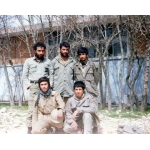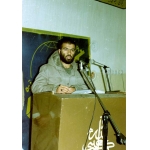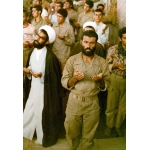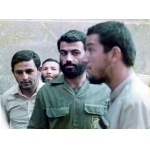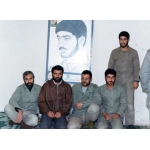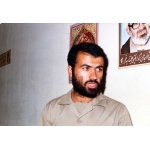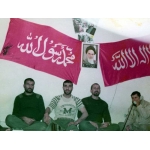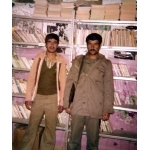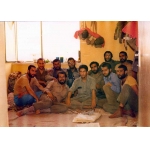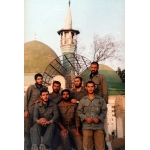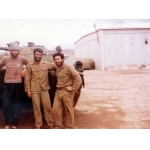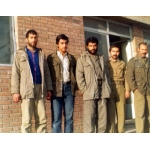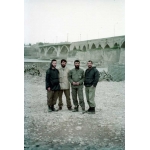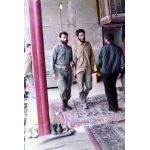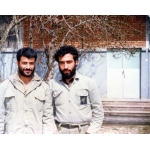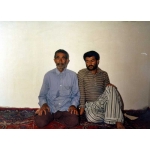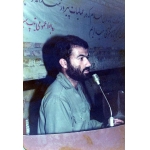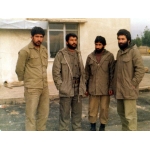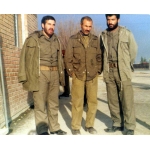Najafi Rastegar, Kazem
Nahid Khodaee
217 بازدید
Kazem Najafi Rastegar (1960–1984) was one of the commanders of the Islamic Revolutionary Guard Corps (IRGC) during the Iran-Iraq War. He served as a battalion and brigade commander, but stepped down from his command after Operation Kheibar due to disagreements with some other commanders. However, he participated in Operation Badr as a soldier and was martyred.
Kazem Najafi Rastegar was born on March 23, 1960, in the village of Ashrafabad v near Rey. While studying in elementary school, one of his relatives introduced him to Ayatollah Seyyed Muhammad Hossaini Beheshti. By attending Ayatollah Beheshti's classes, he became familiar with Imam Khomeini's movement and revolutionary forces, which marked the beginning of his engagement in revolutionary activities. He was part of the team responsible for providing security for Imam Khomeini's return to Iran, accompanying him from the airport to Alavi School.
After the victory of the Islamic Revolution, Najafi Rastegar briefly served in the Islamic Revolutionary Committee, where he was responsible for guarding the Sadabad Palace. Following its establishment in 1979, he joined the IRGC shortly after finishing high school and began serving in the Towhid Garrison in Rey. In 1980, alongside his friends Nasser Shiri, Muhammad Abolqasemi, and Davood Farokhzad, he went to Firuzkuh to form and organize the local IRGC. Rastegar took on the responsibility of training the forces at a time when communist groups, the Tudeh Party, and the Mojahedin-e Khalq Organization were active in Firuzkuh. Through their efforts, Rastegar and his comrades managed to secure the area.
That same year, Rastegar completed a specialized ranger course under the supervision of Mustafa Chamran. Subsequently, he and Nasser Shiri joined Chamran's group in Sardasht, Kurdistan, to fight against anti-revolutionary elements.
In late September 1980, as Rastegar and Shiri were returning to Tehran after completing their mission in Kurdistan, they heard about Iraq's invasion of Iran. Therefore, they headed to Qasr-e Shirin and Dasht-e Zahab, where they joined the Towhid Garrison forces positioned in the Darbalout front. At that time, Rastegar led the operations unit of the first platoon of the Towhid Garrison, commanded by Mahmoud Sabetnia.
On March 5, 1981, Rastegar and Sabetnia's platoon launched an operation on Hill 09, located 500 meters from Iraqi positions. The operation yielded positive results. Afterwards, Rastegar returned to Tehran and spent the Nowruz holidays working in the operations unit at the Towhid Garrison.
During this time, Tehran was experiencing a challenging and unstable situation. The Mojahedin-e Khalq Organization and other anti-revolutionary groups began their terrorist activities the first of which was the demonstrations held from Ferdowsi Street to Enqelab Square on June 20, 1981. Later on, a series of terrorist attacks by these groups created insecurity in Tehran, including the assassination attempt on Ayatollah Seyyed Ali Khamenei (the then-representative of Imam Khomeini (ra) in the Supreme Defense Council and Tehran's Friday Prayer Leader) and the bombing at the Islamic Republican Party office, which resulted in the martyrdom of Ayatollah Seyyed Muhammad Beheshti and several others.
The operational units of the IRGC actively worked to counter these threats. Rastegar also played a key role in the operations unit, working tirelessly. During this period, his wedding ceremony e with Akram Abolqasemi (the sister of his close friend Muhammad Haj Abolqasemi) was postponed out of respect for the martyrdom of Beheshti and his companions.
On June 29, Rastegar joined the Iranian forces on the front lines, and in late August he briefly returned to Tehran for his wedding ceremony. However, the ceremony, planned for August 30, was cancelled because of the martyrdom of President Muhammad Ali Rajaei and Prime Minister Muhammad Javad Bahonar. Finally, on October 1, 1981, he celebrated his wedding and began his married life.
In March 1982, while the forces were preparing for Operation Fath al-Mobin, Iraq attacked Chazabeh and Nabaeh Hills to reclaim Bostan. At the time, Rastegar was the commander of the Imam Hussain (as) Battalion, a unit within the 25th Karbala Brigade, led by Morteza Qorbani. He dispatched his forces to defend Chazabeh and Nabaeh Hills.
In the Operation Molay-e Motaqyan, which began on February 20, 1982, and lasted for 14 days, Rastegar and his battalion played a critical role, holding the lines for 48 hours and securing the hills until reinforcements arrived. After the operation, Rastegar and his forces took a short leave before returning to Ahvaz. He continued to train his forces daily to prepare them for upcoming operations.
Operation Fath al-Mobin commenced on March 22, 1982, during which Rastegar and his forces were stationed at the Reqabiyeh Hills and successfully captured the radar site west of Shush.
After this operation, Kazem Rastegar was transferred from the Karbala Brigade to the 27th Muhammad Rasulullah (pbuh) Brigade, where he served alongside Ahmad Motevaselian, the brigade commander. In late April 1982, during the second phase of Operation Beit al-Muqaddas, he took command of the Meysam Battalion, replacing Abbas Shaaf, who had been injured. The forces of the Meysam Battalion managed to push the Iraqis back to the border markers. In the third phase of the operation, Abbas Shaaf left the hospital to join the battalion. Rastegar and Shaaf jointly commanded the Meysam Battalion during this phase, in which Shaaf was martyred. During the fourth phase and under Rastegar's command, the battalion played a crucial role in cutting off the Iraqi army's supply lines at the Khayin Canal, which contributed significantly to the liberation of Khorramshahr on May 24, 1982. Many members of the battalion were martyred in this phase of the operation.
Following this operation, Kazem Rastegar and several forces of the 27th Muhammad Rasulullah (pbuh) Division were deployed to Syria and Lebanon. Initially, Ahmad Motevaselian led the group, with Rastegar serving as the operations officer. After Motevaselian was captured by Phalangist forces, Rastegar assumed command. One of his notable actions during his four-month stay in Syria and Lebanon was the liberation of two Iranian captives from the Phalangists.
After returning from Syria and Lebanon, Rastegar accepted Ali Movahed Danesh's suggestion to form the 10th Seyyed al-Shuhada (as) Brigade and took responsibility for its planning and operations unit. After the successful Operation Moslim ibn Aqil, Movahed Danesh stepped down as the brigade commander, and upon his suggestion, Rastegar was appointed as the new commander. For Rastegar training was the priority, which helped the forces to be prepared for participation in Operation Valfajr. This operation with Rastegar commanding seven battalions, took place from February 6 to February 15, 1983, in the Fakkeh region. However, it failed due to various reasons.
Operation Valfajr 1 began on April 10, 1983, in the northwest of Hamrin Heights and Fakkeh. Under Rastegar’s command, the 10th Seyyed al-Shuhada (as) Brigade proved its effectiveness in this operation. On the 20th of July 1983, during Operation Valfajr 2 conducted in the Haj Omran Heights, the brigade once again achieved significant success. Kazem Rastegar and his forces also played a pivotal role in Operation Valfajr 4, launched on October 19, 1983, in the Kani-Manga Heights.
Before the formation of the 10th Seyyed al-Shuhada (as) Brigade, Rastegar's wife persuaded him to move to Dezful to live together. Later, they relocated to the organizational housing at Allah Akbar Garrison in Eslamabad. After Operation Valfajr 4, he took his wife to Tehran. During this brief trip, he met Imam Khomeini (ra) to report on Operation Valfajr 4. Operation Kheibar began on February 22, 1984. Until then, the Seyyed al-Shuhada (as) Brigade had mainly operated in mountainous areas, but this operation required fighting in plains and waterlogged areas. Rastegar was initially reluctant about the brigade's involvement but ultimately accepted the mission as the senior commanders ordered. This operation lasted about 16 days, resulting in heavy casualties among the soldiers and significant damage to the brigade. However, the Iranian forces managed to retain the Majnoon Islands. The martyrdom of many of Rastegar's comrades, especially Muhammad Ebrahim Hemmat, deeply affected him.
Rastegar was relieved of his command of the 10th Seyyed al-Shuhada (as) Brigade after operation Kheibar. Then, he joined the Imam Hussain (as) Garrison as a Basij volunteer, working alongside Nasser Shiri to train the forces and prepare educational materials. He also accompanied Shiri on several missions to the western and southern fronts.
A few days before Operation Badr (March 11–17, 1985), Rastegar and Nasser Shiri joined the front lines to participate in the operation as part of the 31st Ashura Division, led by their friend Mahdi Bakeri. On March 16, 1985, Kazem Rastegar, Hassan Bahmani, and Nasser Shiri were martyred in the Jafir region east of Basra due to shrapnel injuries. Rastegar's body remained in the area for 13 years before being recovered and buried in Tehran's Behesht Zahra Cemetery on October 20, 1997. Kazem Rastegar had a daughter, Hoda, who was only 40 days old at the time of his martyrdom.


